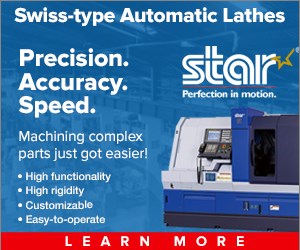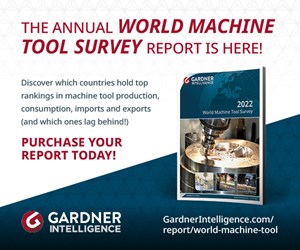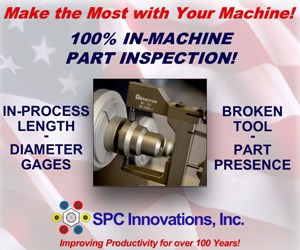Thoughts About the ‘Softer’ Side of Machining
During a live interview at IMTS 2024, I talked about how the application of software and data-driven methodologies can enable shops to improve shopfloor efficiency and overall profitability.
During IMTS 2024, Bill Herman, vice president of sales and membership for AMT – The Association for Manufacturing Technology (left), interviewed me and Modern Machine Shop’s editor-in-chief Brent Donaldson about the application of data-driven manufacturing processes in machine shops. Source: PM
Examples of equipment connectivity were prevalent throughout last month’s International Manufacturing Technology Show (IMTS). Knowing this would be the case going in, Brent Donaldson, editor-in-chief of sister brand Modern Machine Shop, and I were happy to be interviewed on the IMTS main stage to talk about our experiences with shops that have used software and data as the impetus to make more informed process-improvement decisions.
Here, I paraphrase some of what I addressed in case you missed that interview while at the show:
What are the biggest challenges machine shops face when transitioning to a data-driven approach, especially for shops that have relied on traditional methods?
Similar to introducing automated processes, it’s important to communicate with your shopfloor team so they understand the value of and reasons for collecting data for the overall good of the company. It’s not about looking over their shoulders or judging even though a person’s productivity might be shown on flatscreens spread out through the shop. The last thing you want is to imply some sort of “Big Brother” initiative.
Plus, consider the volume of data that could be collected. It can be overwhelming. The key is to start small. Just knowing when a machine’s spindle is in cut can be important. This can be done using sensors to check current flow to the spindle. And it might also make sense to initially start collecting data from just one machine or a single machining cell. Think about low-hanging fruit in terms of process improvements before getting more granular.
How can machine shops maintain the balance between automated data collection and human expertise in decision-making processes?
The reality as you all know is there isn’t as much old school machinist experience out there. That is, those who can hear/recognize when a cutter might be dulling, figure out why a surface finish is poor and so on. So there’s an extent to which there’s not an option to not collect machining and manufacturing data.

Adaptive machining technology can not only enable reliable unattended machining, but automatically alter feed rates to minimize cycle times.
But the human element is something of which to be mindful. Shops should consider one crucial metric that is often missing in all this data: operator identity. It’s one thing to know how much time a piece of equipment was under power, what tools and materials were used and precisely what was done the entire time a machine was operational. However, who was in control?
How does the role of data differ between high-volume production environments and low-volume, high-mix shops?
In terms of high-volume production, I tend to draw a parallel between collecting data and unattended machining. Much of the equipment we cover in Production Machining is configured to run unattended. The simplest form is a bar feeder for turning equipment.
But then think about the high volume of parts coming off something like CNC multispindles. These can produce the same amount of parts as, say, three Swiss-types. We’re talking parts being completed in seconds, not minutes and often running unattended overnight or over long stretches of time. So, if parts start falling out of specification, there could be a lot of scrap or rework. Then there’s also the possibility of tool breakage.
Machine monitoring can help answer the “Why?” question.
If that machine goes down for an extended period of time, do you have three Swiss-types open to take on that work? Something like adaptive tool monitoring technology can, in real time, monitor tool wear to automatically change offsets or detect tool breakage. And think about something perhaps less obvious like coolant pressure. Do you have a means to monitor that? An interruption to coolant delivery could lead to tool breakage. Be mindful that perceived “little” issues can lead to big problems when it comes to unattended machining.
How can data-driven methodologies help machine shops stay competitive in an increasingly global manufacturing environment?
I appreciate that machine monitoring can help answer the “why?” question. What caused a tool to unexpectedly break? Why is this machine down for a set up twice as long as expected? Is it because there’s something off with the process or, instead, is the machine operator somehow not following the process? If it’s the latter, then this can lead to a “teachable moment” that production managers can use to help build the knowledge base for less-experienced employees.
What Say You?
If you are an equipment manufacturer or software provider, I’d like to hear how your offerings help shops down the path of data-driven manufacturing and machine monitoring. Similarly, if you’re a shop applying this technology, I’d like to hear about your experiences. Email me at dkorn@productionmachining.com.
Related Content
Automation Idea for Halloween?
Maybe not. But, the candy-throwing robots at MetalQuest’s Nebraska facility do enable the contract machine shop to stand out at career fairs and similar events.
Read More4 Bright Ideas for Effective Lights-Out Machining
Adopting lights-out machining involves considerations when a machine shop decides to move forward with the process. Here are some tips to a successful implementation.
Read MoreCNC Machine Shop Employment Positions to Consider Beyond Machine Operators
Many machine shops have open machine operator positions to fill. But does it make sense for shops to also seek automation engineers, IT managers and assembly personnel?
Read MoreZoller Event Shines Lights on Shopfloor Connectivity
The company’s open house event highlighted smart manufacturing solutions from CAM to part.
Read MoreRead Next
Do You Have Single Points of Failure?
Plans need to be in place before a catastrophic event occurs.
Read MoreA Tooling Workshop Worth a Visit
Marubeni Citizen-Cincom’s tooling and accessory workshop offers a chance to learn more about ancillary devices that can boost machining efficiency and capability.
Read MoreEmerging Leaders Nominations Now Open
Here’s your chance to highlight a young person in your manufacturing business who is on the path to be a future leader moving your company forward.
Read More












.jpg;maxWidth=300;quality=90)










